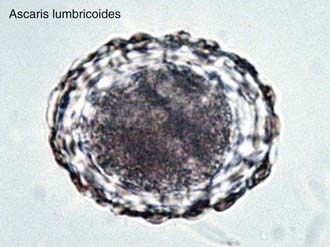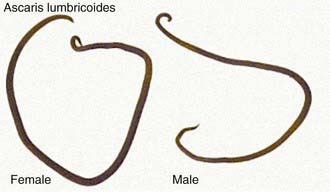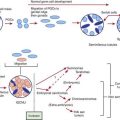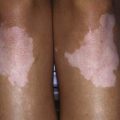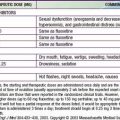Chapter 283 Ascariasis (Ascaris lumbricoides)
Etiology
Ascariasis is caused by the nematode, or roundworm, Ascaris lumbricoides. Adult worms of A. lumbricoides inhabit the lumen of the small intestine and have a life span of 10-24 mo. The reproductive potential of Ascaris is prodigious; a gravid female worm produces 200,000 eggs/day. The fertile ova are oval in shape with a thick mammillated covering measuring 45-70 µm in length and 35-50 µm in breadth (Fig. 283-1). After passage in the feces, the eggs embryonate and become infective in 5-10 days under favorable environmental conditions. Adult worms can live for 12-18 mo (Fig. 283-2).
Diagnosis
Microscopic examination of fecal smears can be used for diagnosis because of the high number of eggs excreted by adult female worms (see Fig. 283-1). A high index of suspicion in the appropriate clinical context is needed to diagnose pulmonary ascariasis or obstruction of the gastrointestinal tract. Ultrasound examination of the abdomen is capable of visualizing intraluminal adult worms.
Bethony J, Brooker S, Albonico M, et al. Soil-transmitted helminth infections: ascariasis, trichuriasis, and hookworm. Lancet. 2006;367:1521-1532.
Gilles HM, Hoffman PS. Treatment of intestinal parasitic infections: a review of nitazoxanide. Trends Parasitol. 2002;18:95-97.
Jardim-Botelho A, Raff S, Rodrigues DA, et al. Hookworm, Ascaris lumbricoides infection and polyparasitism associated with poor cognitive performance in Brazilian schoolchildren. Trop Med Int Health. 2008;13:994-1004.
Keiser J, Utzinger J. Efficacy of current drugs against soil-transmitted helminth infections: systematic review and meta-analysis. JAMA. 2008;299:1937-1948.
Shah OJ, Zargar SA, Robbani I. Biliary ascariasis: a review. World J Surg. 2006;30:1500-1506.

